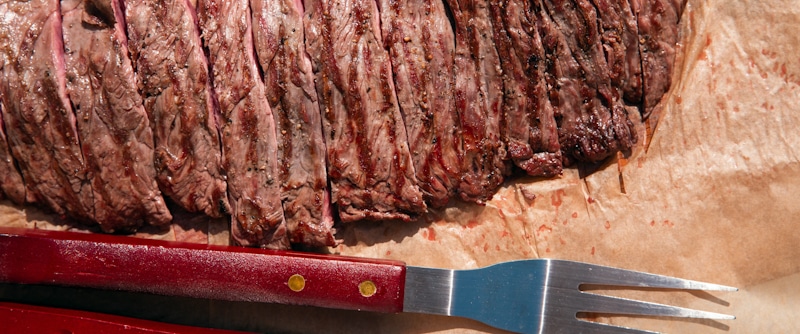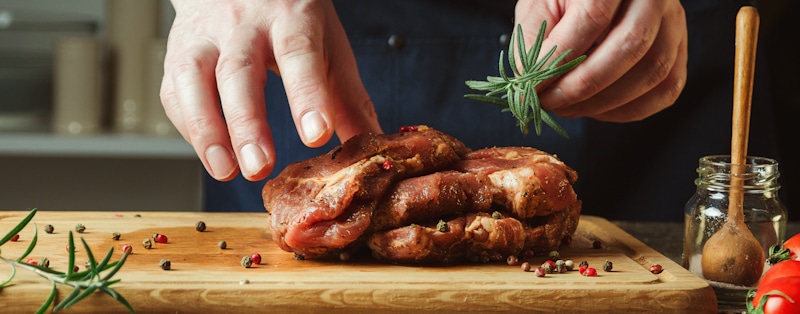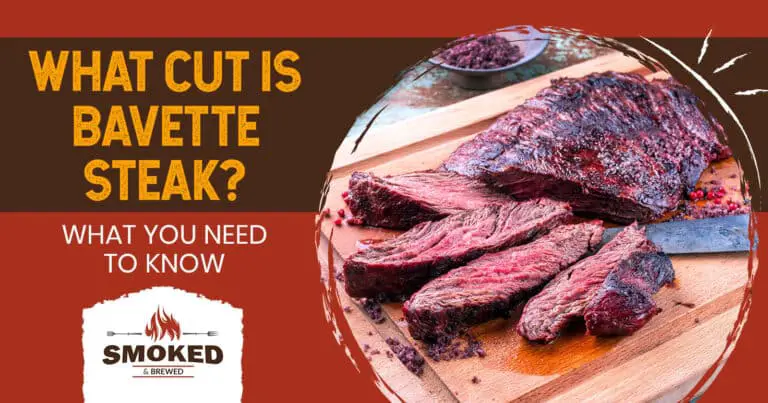For any BBQ enthusiast, understanding the different types of steak is key to cooking a delicious meal because various steaks require different cooking methods. So, what cut is Bavette steak?
The Bavette steak, also referred to as flap steak, is a tender, flavorful, and flat cut of meat obtained from the cow’s abdominal part. Precisely, the steak is cut from the cow’s area adjacent to the flank. While the Bavette steak is best known for its grainy loose texture and delicious beefy flavor, it is relatively affordable.
The fibrous nature of the Bavette steak requires that you put it through some treatment before cooking it to ensure it is delicious. Continue reading for more information if you are not sure whether the Bavette steak is the right choice.

What Cut Is Bavette Steak?
The Bavette steak, also known as the flap steak, is obtained from the abdominal area of a cow. The steak was also once referred to as butcher’s steak because butchers used to reserve it for themselves. Additionally, some people consider the Bavette steak a primary steak cut like the sirloin or the rib-eye. While you can make a delicious 5-star restaurant meal from the steak, it is available at a lower price in most outlets.
What To Look For When Purchasing Bavette
If you plan to cook a delicious bavette steak, you should start by ensuring that you invest in a quality steak. Most barbecue enthusiasts recommend a dry-aged steak. Although such a steak is likely to be a bit more expensive, it has a deep, fulfilling, beefy flavor. Further, settle for a thicker bavette steak to make it hard to overcook the meat. Besides, a thicker cut will likely have more marbling to keep the meat juicy when grilling.
Why Is It Called Bavette Steak?
So why do you think the steak is called bavette steak? The name bavette has a French word origin, ‘bib,’ describing the shape of the cut and the area of the cow from where it is derived. While the bavette steak comes from the same area as the skirt and the flank steak, the three steaks have varying qualities. The bavette is the cheapest of the three similar steaks.
Is Bavette The Same As Hanger Steak?
It is easy to confuse the hanger steak and the Bavette steak. Although in the UK, the bavette steak is referred to as the hanger steak and the butcher’s cut in the US, these cuts are not the same.
The hanger steak gets its name because it hangs between the rib and the tenderloin. It is situated deep inside the loin and encircled by the rib cage. Consequently, the cut is not overworked and, therefore, relatively tender. Some old-school butchers refer to the steak as the hanging tender.
What’s The Difference Between Bavette And Flank Steak?
The flank, skirt, flatiron, hanger, and bavette steaks are all similar in one way or the other. In most instances, butchers reserve these cuts for themselves, and this is because these cuts have some exciting traits that make them even more delicious.
The only way to understand the differences between the flank steak and the bavette steak is to understand each separately.
The Flank Steak
The flank steak is cut from the belly close to the hind legs of a cow. Since the muscles on the abdomen close to the back legs are pretty worked out, the flank steak tends to be a bit lean and tough. Therefore, when cooking a flank steak, you will need to do a little job to make it tender.
The trick to making a flank steak tender and delicious is to marinate it before cooking. Also, you may use a mallet to break down some of its fibers. When slicing the meat, ensure that you cut it into super thin slices.
The Bavette Steak
The bavette steak is cut from the abdominal part of the cow close to the sirloin and flank steak. The cut has a loose, grainy texture since it comes from a less worked area. Unlike the flank steak, the bavette steak is tender with a beefy flavor. However, the flank steak has a higher price tag than the bavette steak.
How Is Bavette Steak Best Cooked?
Although the bavette steak has an incredible beefy flavor and tenderness, you need to understand the best way to cook it for a delicious meal. You will not love the end product if you get it wrong when cooking the steak.
The best way to cook a bavette steak is to start by marinating it well before cooking. Here is how to perfectly cook a great bavette steak.
Preparation
It is necessary to start the prep work by bringing the steak to room temperature. This is important because it guarantees uniform cooking of the steak, as you would not want to have a steak charred on the outside but cold inside.
After bringing the steak to room temperature, the next step is to cut off any excess fat before rubbing it with your favorite marinade. A good marinade will not only enhance the meat’s flavor but also make it tender. Moreover, the loose meat grain makes it easy for the steak to absorb the marinade and dry rubs easily.
On The Stovetop
The objective of cooking the steak on the stovetop is to cook it quickly at high temperature and bring it to a medium-rare level of doneness. For the best sear, use a cast iron skillet, and bear in mind that the steak will keep cooking after you remove it from the heat source for a few minutes.
Cook each side of the steak for about three minutes each side. Further, you need to factor in the thicker side of the steak and adjust accordingly to ensure that you do not undercook or overcook the steak.
On The Grill
If you want to cook the steak on the grill, embrace the two-zone heating method. As always, ensure that the steak is well-marinated before cooking. Additionally, cook the steak at high temperatures because cooking it at a low temperature will result in a drier steak.

Rest The Steak
According to USDA, the safe internal temperature for meat is 145 degrees Fahrenheit. At this temperature, the meat is safe for consumption. It is good to have a digital thermometer to help you measure the steak’s internal temperature.
Further, you should rest the steak for about 15 minutes after getting it out of the heat source. This is necessary because it helps the juices recirculate and ensure that most of them do not escape when slicing the meat.
Essential Cooking Tips For The Bavette Steak
- Use quality marinade to enhance the flavor of the steak. With its loose meat grains, the bavette steak never disappoints when it comes to absorbing the marinades.
- For BBQs, use chilling and lime in the marinade to give it a Mexican touch.
- The trick to cooking a delicious and juicy steak is to cook it quickly and at a high temperature. Cooking it low and slow will result in a dry steak, which is not what you want.
- Avoid using the steak immediately after it is out of the freezer. Instead, bring it to room temperature before cooking it. This ensures that the steak cooks evenly.
- Rest the steak on foil paper before slicing for an even distribution of the juices
- Always cut the steak against the grain of the meat.
Conclusion
While the bavette steak is quite an underappreciated cut of meat, its beefy flavor and excellent level of tenderness are worth trying out. Moreover, the steak is more affordable and easy to cook than its counterpart, such as the flank steak. As long as you cook it well, it is a delicious steak to try out.
Scot has loved smoking food in his free time for the last few years. Each major holiday or off-weekend, Scot spends days testing and prepping new recipes for perfection.

